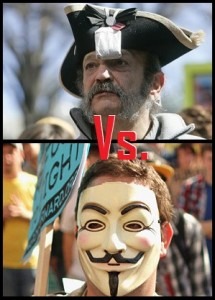Depending on what channel you are watching, you’ve most likely heard the Occupy Wall Street demonstrators characterized as the heroic organized youth of the nation OR an unruly bunch of long-haired, volatile hippies who smell equally of patchouli, Zuccotti Park funk and lingering pepper-spray. Similarly, you’ve probably heard the Tea Party characterized as independent-thinking patriots who want to free Americans from tyranny OR a group of racist, tri-corner hat wearing, mouth-breathing, senile old twits who don’t know enough to understand that “tea-baggers” is kind of an insult.
So, with the Occupy Wall Street movement approaching its eighth week (youthful outrage grows up so fast, doesn’t it?), and the Tea Party still a powerful force in politics, I thought it would be worth it to look into the numbers and messages of these two forces.
Demographics
The Tea Party movement certainly fulfills the stereotype that has been laid out for them. According to a Gallup poll, the Tea Party is overwhelmingly white (79%), typically wealthy (55% making over $50,000) and often Republican (49%). For the most part, Tea Party protestors are older— but not by as much as you’d think. They are pretty close to a cross-section of the American population in regards to age.
The demographic of the Occupy Wall Street movement is a little more surprising. As much as the protest has been called the Democrats' response to the Tea Party, the reality is that most Occupy Wall Street members are independent (70%). They are typically young (64% under the age of 35), less wealthy (71% making under $50,000), and more ethnically diverse.
Size & Support
The Tea Party is the older movement; it is roughly 22 months old (unless you count the Tea Party thing that happened in the Boston Harbor, in which case they are a spry 237 years old). Though support for the Tea Party usually hovers around 30% (according to the AP), the biggest rally for the Tea Party was over 60,000 people (September 12, 2009 in Washington, D.C.). The Tea Party and The Tea Party Patriots Facebook pages have more than one million "likes" between them.
The Occupy Wall Street movement tends to hover around 35% favorability. At its largest, the group in New York City swelled to 15,000, but with a revolving door of protestors who have been there for over a month, the number of protestors could be as high as 20,000. In addition, there have been Occupy protests in 70 major cities and in Europe. The Occupy movement seems to thrive on the internet, though-- well over 250,000 people support some chapter of the Occupy movement on a social networking site.
Celebrity Support
The Tea Party is not exactly the Aspen of political movements - celebrity sightings are rare. Most of the famous people attending these rallies are pundits and politicians (Donald Trump, Glenn Beck, Sarah Palin, to name a few). The few celebrity supporters include Victoria Jackson, Pat Boone and Ted Nugent.
The Occupy movement, claims Alec Baldwin, Racheal McAdams, and Tim Robbins. In addition, musicians like Tom Morello, Pete Seeger, and Kayne West provide a lovely soundtrack to being pepper-sprayed. Which brings us to…
Violence & Arrests
While there have been a few incidents that the media tied to the Team Party, Tea Party rallies have not (as far as I can tell) been involved with any arrests, any allegations of violence or any run-ins with law enforcement.
The Occupy movement has not been so lucky. The number of arrests made at Occupy movements seems to be near 2,500 and still growing. There have been many times when police officials felt compelled to react and control the crowd (most notably in Oakland, as one HeadCount blogger has discussed). Perhaps worst of all, there have even been reports of sexual assault at Occupy events.
Lunatics
All good protests have a fair amount of lunatics (it just wouldn’t be a protest without them.) They’re needed to make the rational protestors look just a little bit less rational. The MVP for Tea Party lunacy will have to go to the classic Obama with a Hitler mustache signs. Not too original—but it’s tough to top a classic.
It’s slightly tougher at the Occupy Wall Street protests. People running around with Guy Fawkes masks seem to be the favorite, but my vote for biggest lunatic goes to the guy relieving himself on a cop car.
Message
Despite all of the media coverage, and the celebrity spotting, and the lunatics— the most important thing in both protests is the message. And, as different as they are on paper, the messages of both protests aren’t that different. As NPR pointed out, both protests come down to “distrust of concentrated power.” While the Tea Party thinks the government has the power, the Occupiers blame big business. Ultimately, both groups’ messages can be boiled down to one thing: they don’t want big faceless institutions to hold more power than the citizens.
Both organizations have different goals: The Tea Party wants to limit governments spending and broaden the tax base while the Occupiers want to close the gap between the wealthy and the poor— but ultimately, both groups want to see the wealth, and the responsibility that comes with wealth, spread around a little more evenly. So, why does the media paint these two movements as polar opposites? Why are these movements being co-opted by warring political parties? How will these two growing movements affect the up-coming election cycle and the bigger political landscape?
We’ll have to wait and see.
